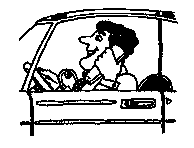Long before the advent of the cell phone, driving distractions came from live events inside a car. Kids fighting in the backseat, a barking dog or a marital spat diverted a driver’s attention.
On slow winding roads, drivers’ eyes took in the panoramic view of the countryside – and this included everything moving along the road. It was a time when a car was not a roving home or office, but a means of traveling from point A to point B. Cycling was safer then because driving was about what was happening on the road. Cyclists could take a leisurely ride knowing that cars would give them a wide berth. In this slower world cars and cyclists coexisted.
Then, sometime in the ‘90s, cell phones emerged.
At first, they were used by people who needed to be available 24/7. An emergency tool, they provided contact with someone who was away from a landline phone. As travel became a larger part of modern life, mobile communication became necessary, or at least desirable.
Distractions now came from far and wide. Dialing the phone, searching for phone numbers, texting and conversations unrelated to the place and time of the vehicle’s travels all became part of the driving life.
As demands on a driver’s time grew, so did the decrease in attention to the road. Cars, traffic signals, pedestrians and cyclists became a glint in the driver’s eye. All the action was inside the car amid the artificial world of voices filling the silence where bodies once sat.
A new realm of transported bodyless passengers created a surreal environment never seen before. This posed a new set of challenges for cyclists who existed outside this novel nomadic social reality. Invisible people conversed with drivers who once watched intently when a cyclist signaled to turn or change lanes.
Cars jolted through turns, dexterous fingers hopped on the steering wheel in short, sharp movements, trying to make up for the loss of one hand. Arguments ensued with nonexistent people. Heads were pressed onto one shoulder, pushing a badly shaped phone into a reddened ear in an attempt to keep the phone in hearing distance. While looking through the corner of one eye at the road ahead, the driver hoped not to crash during the intermittent seconds of inattention. Looking down was followed by a brief glance upward to see if anything of importance was in sight.
These were the new drivers, temporary motorists caught between two worlds, yet present in neither. Riding near them was cause for concern. Cyclists became invisible, especially when cruising alongside a car where the driver’s tilted head could not perceive them. A cyclist’s life depended on peripheral vision. Yet, with something against one ear, a driver could only see straight ahead.
Screeching brakes, oblivious turns and road rage became the norm. And with this new mobile world came a fury aimed at anything requiring attention or extra steering to avoid hitting an obstacle.
Drivers blew their horns and cursed cyclists for moving slowly. They yelled out windows, bullying vehicles to get out of their way – and in general, created a hostile environment for anyone in their path.
Chatting solo drivers could frequently be seen through side windows by cyclists gliding past on the right. One hand held up to their ear, babbling postponable nonsense, it was an instantaneous world of refusing to be alone.
Riding in a sphere outside the perception of the operator of a mass of steel became a life-threatening experience. Not one second of peace was allotted to cyclists, for constant alertness was mandatory. Trying to stay out of the way of people who were not in control of their cars constituted cell phone defiant cycling. Darting, swerving, shouting and banging on hoods of cars all became necessary for cyclists to gain the attention of the cell phone wielding warriors.
Longing for the dawdling days of driving as a pastime could not end the ever-communicating madness. In these cell phone abiding times, life traveled with the driver and the cyclist would forever be an afterthought.




